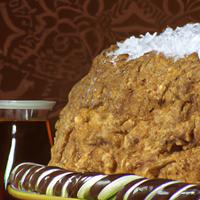
1 serving (100 grams) contains 350 calories, 5.0 grams of protein, 15.0 grams of fat, and 50.0 grams of carbohydrates.

Log this food in SnapCalorie

Nutrition Information
Calories |
833.3 | ||
|---|---|---|---|
% Daily Value* |
|||
| Total Fat | 35.7 g | 45% | |
| Saturated Fat | 19.0 g | 95% | |
| Polyunsaturated Fat | 0 g | ||
| Cholesterol | 23.8 mg | 7% | |
| Sodium | 476.2 mg | 20% | |
| Total Carbohydrates | 119.0 g | 43% | |
| Dietary Fiber | 4.8 g | 17% | |
| Sugars | 71.4 g | ||
| protein | 11.9 g | 23% | |
| Vitamin D | 0 mcg | 0% | |
| Calcium | 119.0 mg | 9% | |
| Iron | 3.6 mg | 20% | |
| Potassium | 238.1 mg | 5% | |
* Percent Daily Values are based on a 2,000 calorie diet. Your daily values may be higher or lower depending on your calorie needs.
Food Attributes
Source of Calories
About Biscuit cake
Biscuit cake is a no-bake dessert popular across various cuisines, particularly in European and South Asian households. Typically made using layers of tea biscuits alternated with a chocolate or condensed milk mixture, it is then chilled to set. The base ingredients often include butter, sugar, cocoa powder, and biscuits, though variations may incorporate nuts, dried fruits, or flavored syrups for added richness. While loved for its simplicity and indulgent taste, biscuit cake is high in sugar and fat, making it a treat best enjoyed in moderation. Some recipes can be adapted using whole-grain biscuits and reduced sweeteners for a healthier twist. Its appeal lies in the combination of crunchy biscuit texture with creamy chocolate layers, creating a satisfying dessert for gatherings or celebrations.



